05.2024 Life Guide
Targeted treatment for female urinary incontinence
Dr. Xiao Shengmou from the Obstetrics and Gynecology Department of Far Eastern Memorial Hospital /


 Urinary incontinence is a common but easily overlooked problem, and many women feel embarrassed or troubled by it, which in turn affects their personal quality of life and confidence. If you notice involuntary leakage of urine from the urethra during physical exertion, running, sneezing, or coughing, be careful of stress urinary incontinence. This issue of "Health Column" introduces the treatment methods for this symptom, helping female patients achieve a permanent solution.
Urinary incontinence is a common but easily overlooked problem, and many women feel embarrassed or troubled by it, which in turn affects their personal quality of life and confidence. If you notice involuntary leakage of urine from the urethra during physical exertion, running, sneezing, or coughing, be careful of stress urinary incontinence. This issue of "Health Column" introduces the treatment methods for this symptom, helping female patients achieve a permanent solution.Treatment methods for stress urinary incontinence
Conservative treatments for female stress urinary incontinence include improving lifestyle, Kegel exercise, medication therapy, and surgical treatment. Among them, Kegel exercise must be performed daily, which is difficult for most patients to persist and therefore ineffective; Drug therapy also requires continuous use of prescription drugs to achieve therapeutic effects.
For patients who do not want to take medication, are not taking medication effectively, or are concerned about drug side effects, previous treatments have been performed with "artificial mesh sling surgery". Although there is a certain therapeutic effect, patients must be hospitalized, and under systemic or semi systemic anesthesia, an absorbable artificial mesh must be inserted through the anterior wall of the vagina to the middle of the urethra. Although the surgery will not affect sexual life after surgery, some male spouses may still feel the presence of the artificial mesh, which may affect sexual life due to pain; A small number of patients may also experience wound pain or poor healing of vaginal wounds, resulting in the exposure of the artificial omentum and requiring further surgery for repair. In addition, after the placement of artificial omentum, women will not be able to produce naturally through the vagina, all of which are the drawbacks of artificial omentum sling surgery.
Vaginal laser therapy
In recent years, the use of laser for vaginal irradiation has emerged in the public. Clinical treatment results in our hospital have shown that it is indeed effective, and after six months of follow-up, the therapeutic effect can still be maintained. The relevant therapeutic effects have been published in SCI (Science Citation Index) journals, becoming the world's first paper on vaginal laser treatment for stress urinary incontinence, and have also been cited by clinical teams from various countries.
Vaginal laser therapy uses carbon dioxide laser with a wavelength of 10600nm, transmitted through miniature light dots (approximately 200 nm) μ m) Combined with dot matrix scanning output and 360 degree and 90 degree vaginal probes, laser energy is stably applied to the deep connective tissue of the perineum or vagina using thermal effects, promoting the renewal and recombination of collagen and elastic fibers, strengthening the structure of the vaginal wall, and treating stress urinary incontinence.
The entire treatment time is only 10-15 minutes, which can be completed in the outpatient department without taking leave or rest. It is almost painless and does not require anesthesia; And there will be no bleeding after treatment, nor will it affect daily life. Therefore, it is recommended that patients with mild urinary incontinence first receive "vaginal laser treatment". If the effect is not satisfactory, then consider "artificial omentum urinary incontinence surgery".
It is worth mentioning that this treatment method also has a good therapeutic effect on dryness and itching of the perineum in postmenopausal women, and is a great blessing for patients who dare not try hormone therapy or have ineffective treatment.
Single incision artificial omentum urinary incontinence surgery
If the symptoms are more severe in patients with stress urinary incontinence, a single incision artificial omental incontinence surgery can be considered. The treatment effect is the same as traditional three incision artificial omental incontinence surgery, but the appearance of the wound is visible in traditional three incision artificial omental incontinence surgery. However, a single incision artificial omental incontinence surgery is almost painless and the appearance does not show scars, making it the first choice for female patients with severe stress urinary incontinence surgery.
epilogue
In many people's minds, urinary incontinence is a shameful thing to talk about, so they avoid seeking medical treatment. But nowadays, the average life expectancy in Taiwan is as high as 80.7 years. Life not only needs to live long, but also needs to live well. Women who suffer from this problem should seek medical assistance in a timely manner, cooperate with medical treatment, and obtain improvement as soon as possible to ensure their quality of life.
Dr. Xiao Shengmou's expertise includes gynecological surgery, gynecological chemotherapy (including intraperitoneal chemotherapy), Da Vinci robotic arm assisted gynecological and gynecological surgery, women's urinary incontinence, bladder overactivity, pelvic prolapse treatment, laparoscopic surgery, and hysteroscopic surgery.
#




















